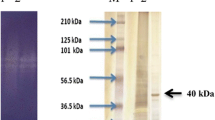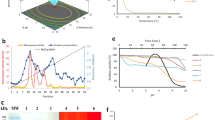Abstract
Production of manno-oligosaccharides (MOSs) from pretreated and defatted copra meal (dFCO) hydrolysis was achieved by endo-mannanase. Structural characterization of dFCO by FT-IR and NMR exhibited resemblance with galactomannan. The time-dependent hydrolysis of dFCO by recombinant endo-β-(1 → 4)-mannanase of Clostridium thermocellum by TLC and HPAEC displayed the release of mannose and MOSs mannobiose and mannotriose. Purified MOSs yielded 40 % mannobiose and 18 % mannotriose confirmed by mass spectroscopy which showed mannobiose (m/z = 365) and mannotriose (m/z = 527). The homology based structural analysis of catalytic endo-mannanase (CtManT) showed the catalytic core composed of Glu181 and Glu300 acting as acid/base and Glu288 as a nucleophile during galactomannan hydrolysis. Sub-site map** of CtManT exhibited two aglycone and four glycone sites at cleavage sites existing on either side of β-(1 → 4)-linkage of galactomannan. Isolated MOSs displayed potential prebiotic characteristics and supported higher growth of probiotic Lactobacillus acidophilus and Bifidobacterium infantis than with standard inulin. Moreover, MOSs displayed over 97 % tolerance to simulated gastric juice, intestinal fluid, and α-amylase proving its potential as a stable prebiotic over inulin. In vitro cytotoxicity assay of MOSs (500 µg/mL) on human epithelial colorectal adenocarcinoma cell line (HT-29) demonstrated 60 % decreased viability of cells after 48 h displaying anti-tumorigenic property.








Similar content being viewed by others
References
Mulimani, V. H., & Naganagouda, K. (2010). Simple laboratory exercise for induction of β-mannanase from Aspergillus niger. Research Journal of Food Science and Education, 9, 76–79.
Hossain, M. Z., Abe, J., & Hizukuri, S. (1996). Multiple forms of β-mannanase from Bacillus sp. KK01. Enzyme Microbial Technology, 18, 95–98.
Kovacs-Nolan, J., Kanatani, H., Nakamura, A., Ibuki, M., & Mine, Y. (2013). β-1,4-mannobiose stimulates innate immune responses and induces TLR4-dependent activation of mouse macrophages but reduces severity of inflammation during endotoxemia in mice. Journal of Nutrition, 143, 384–391. doi:10.3945/jn.112.167866.
Yang, C., Rupa, P., Kanatani, H., Nakamura, A., Ibuki, M., & Mine, Y. (2013). Therapeutic effects of β1,4 mannobiose in a Balb/c mouse model of intranasally-induced pollen allergy. Allergology International, 62, 65–76.
Gibson, G. R., Ottaway, P. B., & Rastall, R. A. (2000). Prebiotics: New developments in functional foods. Oxford, UK: Wood head. 108 pp.
Hongpattarakere, T. (2013). Improvement of freeze-dried Lactobacillus plantarum survival using water extracts and crude fibers from food crops. Food Bioprocess Technology, 6, 1885–1896.
Ishihara, N., Chu, D. C., Akachi, S., & Juneja, L. R. (2000). Preventive effect of partially hydrolyzed guar gum on infection of Salmonella enterica in young and laying hens. Poultry Science, 79, 689–697.
Spring, P., Wenk, C., Dawson, K. A., & Newman, K. E. (2000). The effect of dietary mannooligosaccharides on ceca of Salmonella challenged broiler chicks. Poultry Science, 78, 205–211.
Lin, T. C., & Chen, C. (2004). Enhanced mannanase production by submerged culture of Aspergillus niger NCH-189 using defatted copra based media. Process Biochemistry, 39, 1103–1109.
Cole, C. L., & Jayson, G. C. (2008). Oligosaccharides as anti-angiogenic agents. Expert Opinion on Biological Therapy, 8, 351–362.
Ghosh, A., Luis, A. S., Brás, J. L. A., Fontes, C. M. G. A., & Goyal, A. (2013). Thermostable recombinant endo-β-(1 → 4)-mannanase from Clostridium thermocellum: Biochemical characterization and manno-oligosaccharides production. Journal of Agricultural and Food Chemistry, 61, 12333–12344.
Naughton, P. J., Mikkelsen, L. L., & Jensen, B. B. (2001). Effects of nondigestible oligosaccharides on Salmonella enterica Serovar Typhimurium and nonpathogenic Escherichia coli in the pig small intestine in vitro. Applied Environmental Microbiology, 67, 3391–3395.
Sluiter, B., Hames, R., Ruiz, C., Scarlata, J., Sluiter D, Templeton, D. & Crocker, D. (2008). Determination of structural carbohydrates and lignin in biomass. In Laboratory Analytical Procedure (LAP). Colorado: Technical Report NREL/TP-510-42618.
Samson, A. S., Cater, C. M., & Mattil, K. F. (1971). Preparation and characterization of total protein isolates. American Association for Clinical Chemistry, 77(8), 182–190.
Bradford, M. M. (1976). Rapid and sensitive method for the quantitation of microgram quantities of protein utilizing the principle of protein–dye binding. Analytical Biochemistry, 72, 248–254.
Nelson, N. (1944). A photometric adaptation of the Somogyi method for the determination of glucose. Journal of Biological Chemistry, 153, 375–380.
Somogyi, M. (1945). A new reagent for the determination of sugars. Journal of Biological Chemistry, 160, 61–68.
Fiser, A., Do, R. K., & Sali, A. (2000). Modeling of loops in protein structures. Protein Science, 9(9), 1753–1773.
Krieger, E., Joo, K., Lee, J., Lee, J., Raman, S., Thompson, J., et al. (2009). Improving physical realism, stereochemistry, and side-chain accuracy in homology modeling: Four approaches that performed well in CASP8. Proteins, 77(9), 114–122.
Laskowski, R. A., MacArthur, M. W., Moss, D. S., & Thornton, J. M. (1993). Procheck—a program to check the stereochemical quality of protein structures. Journal of Applied Crystal, 26, 283–291.
Wiederstein, M., & Sippl, M. J. (2007). ProSA-web: Interactive web service for the recognition of errors in three-dimensional structures of proteins. Nucleic Acids Research, 35, 407–410.
Morris, G. M., Goodsell, D. S., Halliday, R. S., Huey, R., Hart, W. E., Richard, K. B., et al. (1998). Automated docking using a Lamarckian genetic algorithm and an empirical binding free energy function. Journal of Computational Chemistry, 19(14), 1639–1662.
Huey, R., Morris, G. M., Olson, A. J., & Goodsell, D. S. (2007). A semiempirical free energy force field with charge-based desolvation. Journal of Computational Chemistry, 28(6), 1145–1152.
Dubois, M., Gilles, K. A., Hamilton, J. K., Rebers, P. A., & Smith, F. (1956). Calorimetric method for determination of sugars and related substances. Analytical Chemistry, 28, 350–356.
Korakli, M., Ganzle, M. G., & Vogel, R. F. (2002). Metabolism by bifidobacteria and lactic acid bacteria of polysaccharides from wheat and rye, and exopolysaccharides produced by Lactobacillus sanfranciscensis. Journal of Applied Microbiology, 92, 958–965.
Fernandez, M. F., Boris, S., & Barbes, C. (2003). Prebiotic properties of human Lactobacilli strains to be used in the gastrointestinal tract. Journal of Applied Microbiology, 94, 449–455.
Wichienchot, S., Jatupornpipat, M., & Rastall, R. A. (2010). Oligosaccharides of pitaya (dragon fruit) flesh and their prebiotic properties. Food Chemistry, 120, 850–857.
Mosmann, T. (1983). Rapid colorimetric assay for cellular growth and survival: Application to proliferation and cytotoxicity assays. Journal of Immunological Methods, 65, 55–63.
Sun, S. N., Yuan, T. Q., Li, M. F., Cao, X. F., Xu, F., & Liu, Q. Y. (2012). Structural characterization of hemicelluloses from bamboo culms (Neosinocalamus affinis). Cellulose Chemistry Technology, 46, 165–176.
Figueiró, S. D., Góes, J. C., Moreira, R. A., & Sombra, A. S. B. (2004). On the physicochemical and dielectric properties of glutaraldehyde crosslinked galactomannan collagen films. Carbohydrate Polymers, 56, 313–320.
Prashanth, M. R. S., Parvathy, K. S., Susheelamma, N. S., Prashanth, K. V. H., Tharanathan, R. N., Chac, A., et al. (2006). Galactomannan esters a simple, cost-effective method of preparation and characterization. Food Hydrocolloid, 20, 1198–1205.
Kacurakova, M., Capeka, P., Sasinkova, V., Wellnerb, N., & Ebringerova, A. (2000). FT-IR study of plant cell wall model compounds: Pectic polysaccharides and hemicelluloses. Carbohydrate Polymers, 43, 195–203.
Peng, Y., Zhang, L., Zeng, F., & Xu, Y. (2003). Structure and antitumor activity of extracellular polysaccharides from mycelium. Carbohydrate Polymers, 54, 297–303.
Zhang, L., Yang, L., Ding, Q., & Chen, X. (1995). Studies on molecular weights of polysaccharides of Auricularia auriculajudae. Carbohydrate Research, 270, 1–10.
Tamaki, Y., Teruya, T., & Tako, M. (2010). The chemical structure of galactomannan isolated from the seeds of Delonix regia. Bioscience, Biotechnology, and Biochemistry, 74(5), 1110–1112.
Rakhmanberdyeva, R. K., & Shashkov, A. S. (2005). Structure of galactomannans from Gleditsia delavayi and G. aquatica BY 1H and 13C NMR spectroscopy. Chemistry of Natural Compounds, 41, 14–16.
Balasubramaniam, K. (1976). Polysaccharides of the kernel of maturing and mature coconuts. Journal of Food Science, 41, 1370–1373.
Cartmell, A., Topakas, E., Ducros, V. M., Suits, M. D., Davies, G. J., & Gilbert, H. J. (2008). The Cellvibrio japonicus mannanase CjMan26C displays a unique exo-mode of action that is conferred by subtle changes to the distal region of the active site. Journal of Biological Chemistry, 283(49), 34403–34413.
Naganagouda, V. K., Patil, A. G. G., & Mulimani, V. H. (2009). Optimization of the production of thermostable endo-β-1,4 mannanases from a newly isolated Aspergillus niger gr and Aspergillus flavus gr. Applied Biochemistry and Biotechnology, 152, 213–223.
Le, N. J., Anderson, L., Stoll, D., Stålbrand, H., & Lo-Leggio, L. (2005). The structure and characterization of a modular endo-beta-1,4-mannanase from Cellulomonas fimi. Biochemistry, 44(38), 12700–12708.
Yan, X. X., An, X. M., Gui, L. L., & Liang, D. C. (2008). From structure to function: Insights into the catalytic substrate specificity and thermostability displayed by Bacillus subtilis mannanase BCman. Journal of Molecular Biology, 379(3), 535–544.
Pereira, D. I. A., & Gibson, G. R. (2002). Cholesterol assimilation by lactic acid bacteria and Bifidobacteria isolated from the human gut. Applied Environmental Microbiology, 68, 4689–4693.
Roe, A. J., O’Byrne, C., McLaggan, D., & Booth, I. R. (2002). Inhibition of Escherichia coli growth by acetic acid: A problem with methionine biosynthesis and homocysteine toxicity. Microbiology, 148, 2215–2222.
Cummings, J. H., & Macfarlane, G. T. (2002). Gastrointestinal effects of prebiotics. British Journal of Nutrition, 87, 1145–1151.
Li, Q., Zhou, S., **g, J., Yang, T., Duan, S., Wang, Z., et al. (2013). Oligosaccharide from apple induces apoptosis and cell cycle arrest in HT29 human colon cancer cells. International Journal of Biological Macromolecules, 57, 245–254.
Acknowledgments
Arabinda Ghosh is supported by a scholarship from University Grants Commission (UGC), New Delhi, India. The mass spectrometric analysis performed in the Department of Chemistry, IIT Guwahati is gratefully acknowledged. The funder has no role in designing the experiments, preparation of this manuscript and bearing any further publication charges. Moreover, authors declare no conflict of interest.
Author information
Authors and Affiliations
Corresponding author
Additional information
Arabinda Ghosh and Anil Kumar Verma contributed equally.
Rights and permissions
About this article
Cite this article
Ghosh, A., Verma, A.K., Tingirikari, J.R. et al. Recovery and Purification of Oligosaccharides from Copra Meal by Recombinant Endo-β-mannanase and Deciphering Molecular Mechanism Involved and Its Role as Potent Therapeutic Agent. Mol Biotechnol 57, 111–127 (2015). https://doi.org/10.1007/s12033-014-9807-4
Published:
Issue Date:
DOI: https://doi.org/10.1007/s12033-014-9807-4




